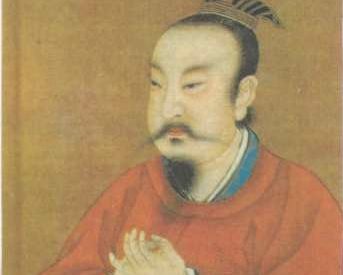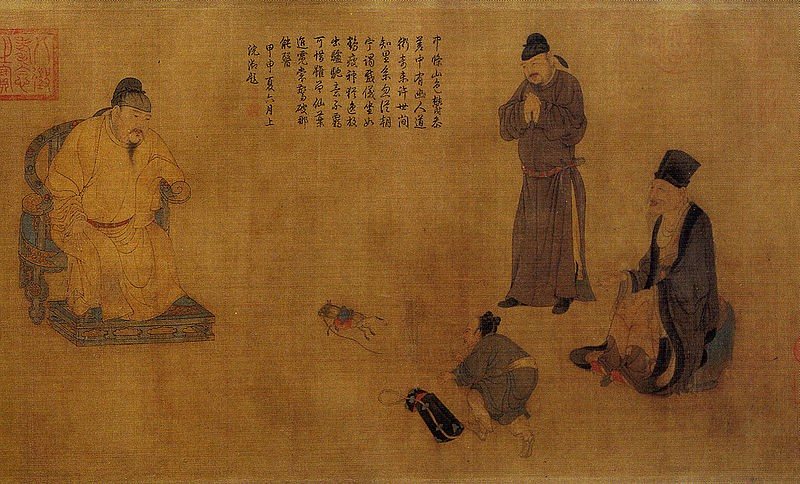 Image Source: Zhang Guo Having an Audience with Emperor Tang Xuangzong. Wikipedia. Public Domain.
Image Source: Zhang Guo Having an Audience with Emperor Tang Xuangzong. Wikipedia. Public Domain.
The Tang Dynasty (618?907) is considered to be China?s golden age. It was a rich, educated and cosmopolitan realm that was well-governed by the standards of the age and expanded its influence in Inner Asia. It saw a flourishing of Chinese poetry and innovation.
Establishment of the Dynasty
China had for centuries been divided. Since the Western Jin Dynasty (265?316) collapsed due to internal infighting and barbarian invasions, much like those that plagued the Roman Empire during that period, China was fractured. There was a succession of dynasties in the North and South. The Sui Dynasty (established in 581) had managed by 589 to reunify all of China by destroying the southern Chen Dynasty. This dynasty was short-lived though. While its founder Emperor Wen (581?604) was a capable ruler, his successor Emperor Yang spent too much money on vast infrastructure projects and pursued an expansion foreign policy, which most disastrously failed in Korea as his invasions were unsuccessful and led to a weakening of the central government and revolts.
Li Yuan, founder of the Tang Dynasty, was a garrison commander in Taiyuan when revolt against the Sui broke out in 613. He marched to the Sui capital in 617 and founded the Tang Dynasty after forcing the abdication of the last Sui Emperor, Yang You. The new dynasty initially ruled only Guanzhong while the northeast, the central plain, and the south were still under the control of rival warlords who had command over hundreds of thousands of troops. It took five years of campaigning by the imperial princes Li Jiancheng and Li Shimin before the country was reunified.
Despite the end of open hostilities in 628, northern Chinese elites attempted to retain their political influence by gathering their supporters in forts. The Tang had to set up forty-three regional military commands across China to enforce order. The basis for the Tang army was the fu-ping militia system (which had its origins in Western Wei and was also used by the Sui Dynasty). The Tang maintained 600 militia units, each containing between 800 and 1,200 men who were liable to serve between the ages of 21 and 60. These units were spread over the countryside but were concentrated around the capitals, with about two-thirds within 170 miles of Chang?an or Luoyang.
Units contained both cavalry and infantry, and were subdivided into t?uan of 200 men, tui of 50, and huo of ten. Officers were permanently employed, but the rank-and-file had to report for duty and training at the capital on a rotation system, depending upon how far away they lived. In the early days of the dynasty, soldiers were largely exempt from taxation and labor service. Each soldier was given land that he or his family and serfs could work. He was expected to supply his own basic arms and provisions, with armor and more elaborate weapons provided by the state.
In addition to those units, the Tang used a central army located in the capital. It consisted of princely guards selected from among the sons of elite families in the area. Expeditionary armies made up of selected well trained soldiers and non-Chinese allies (mainly Turks) were used for single campaigns and were meant to be a rapid force capable of delivering smashing victories (like those of Emperor Taizong).
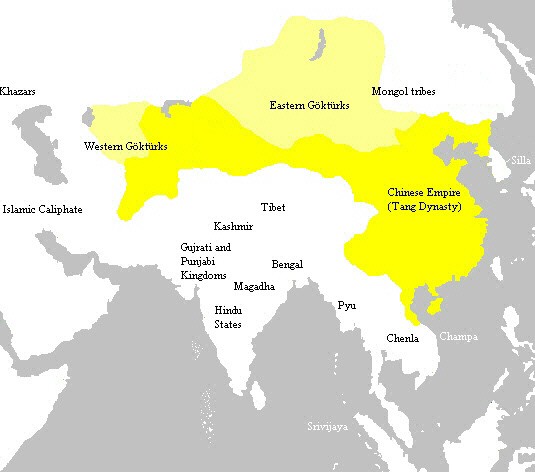 Image Source: Tang dynasty at its greatest extent, c. 669. Wikipedia. Creative Commons Attribution-Share Alike 2.5 Generic license.
Image Source: Tang dynasty at its greatest extent, c. 669. Wikipedia. Creative Commons Attribution-Share Alike 2.5 Generic license.
The Tang cavalry adopted the Turkish combination of lance and bow. The infantry was divided into pu-ping (infantry armed with spears) and pu-she (archers). The Tang armies protected themselves with elaborate fortified camps. Each division had its own enclosed camp; these were linked together with walls and paths, and were sited 50 to 100 paces apart so that they could support each other with missiles. Small towers were built where the paths intersected and could be used to warn other units in the area (by sending fire signals).
Aside from military reorganization and restoring governmental control over the country, the early Tang Dynasty also had to solve fiscal problems. As the state treasury was exhausted due to the wars of the previous period, the Tang adopted the equal-field system of state-granted land, thus ensuring a steady flow of tax revenue. In kind payments (mainly grain and cloth) constituted 90% of the state?s revenues while 10% was collected on coin. In 621 the Tang began minting copper coins in order to stabilize the monetary system which had been destabilized by devaluations in the previous period. By 755 the government had eleven mints with ninety-nine furnaces producing copper coins. Greater ease of transportation between north and south due to the Grand Canal (built by the previous Sui Dynasty) and thriving traffic across the Silk Road simulated long distance trade during the early Tang period. More than fifty tribute missions were exchanged between the Tang and Indian princes before 750.
The Tang faced the threat of Turkish nomads from the north. The Turks were launching large scale invasion of Tang and despite payments by the Empire, which hoped to bribe them away, they continued their destructive invasions. This situation changed when in 626 the capable prince Li Shimin killed his brothers and imprisoned his father in a coup. In 627 an internal division among the Turks that split them in two allowed Li Shimin (better known as Emperor Taizong) to destroy the eastern Turkish empire and place his own Turkish allies in control of the frontier. In 630 he was granted the tile of Heavenly Qaghan, a recognition of his influence. Taizong followed a policy of resettling the eastern Turks on the Ordos plateau while fomenting revolts in the western Turkish state. In 642, the western Turks formally acknowledged their submission to the Tang, ensuring Tang control over central Asia. The Tang however faced a failure in their attempts to invade Korea.
Wu Zetian and Xuanzong
Taizong died in 649 and the reign of his successor Emperor Gaozong (649?683) saw the rise to power of Wu Zetian, a concubine who became his second empress. On domestic affairs, Gaozong issued a revision of the Tang legal code while on foreign affairs he continued to dominate the Turks while finally managing to conquer the Korean state of Koguryo in 668. In 657, Luoyang was established as capital of the Tang (from Chang?an). By 650s however Wu Zetian was increasingly dominating her husband and she ruled after his death in 683 until her deposition in 705, establishing her own dynasty in 690 and ruling as Empress.
Sources tend to be hostile towards her rule and historians cannot agree on how much of the gossip regarding her was true. In an attempt to weaken the powerful bureaucratic elite that was hostile to her she established numerous new posts that she filled with men she trusted. She also created a think tank of informal advisers (Northern Gate scholars) outside the official bureaucracy. On foreign policy she faced hurdles as Tibet encroached Tang?s hold on central Asia and between 670 and 680 the Chinese lost several strategic holdings in the Tarim basin. In 695, the Tang suffered a great defeat at the hands of the Tibetans.
When Wu Zetian was overthrown, her son Zhongzong came to the throne but he was a weak ruler that died (possibly due to poisoning) in 710, having reigned only five years. A son of Empress Wu, Emperor Ruizong, came to the throne but only two years later in 712 he abdicated in favor of his son, Emperor Xuanzong. In his initial years, Emperor Xuanzong is considered to have been an industrious ruler who returned Tang to its previous era of prowess. The emperor had great respect for officials and allowed them to have a genuine role in decision making. In his later years though the emperor became increasingly enamored with the concubine Yang Guifei and promoted several of her kin into high offices. He also allowed An Lushan, a non-Chinese military commander who commanded the empire?s single largest force in the northeast, to gain much power and influence. When political rivals of An Lushan attempted to undercut his influence, he revolted.
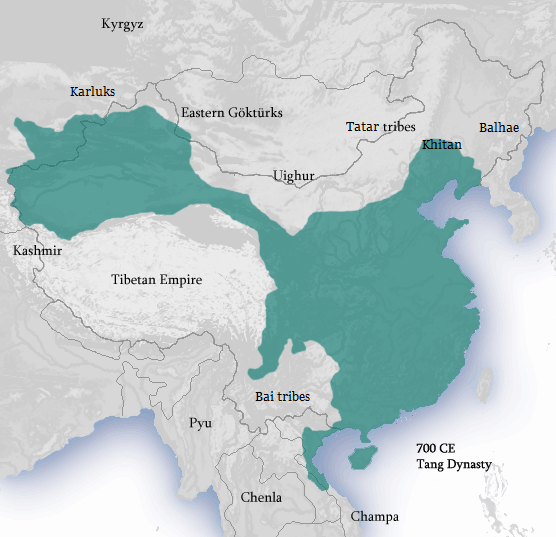 Image Source: Tang Dynasty in 700 CE. Wikipedia. Creative Commons Attribution-Share Alike 3.0 Unported license
Image Source: Tang Dynasty in 700 CE. Wikipedia. Creative Commons Attribution-Share Alike 3.0 Unported license
The conditions that allowed the revolt of An Lushan can be traced back to Empress Wu?s reign. With the threat of Nanzhao in the southwest, Tibet in the west, the Khitan and Bohai in the east and the Turks in the north, the Tang military units had become obsolete. In the 690s, because of the military crisis the Empire faced, Empress Wu kept large number of soldiers at the frontier for long time. Those who belonged to elite families began avoiding military service, forcing the Empire to recruit men from poorer families in order to meets its quotas. By 749 the fu-ping militia were not called to serve.
The frontier armies emerged as the main military force of the Dynasty. The state began offering payments for voluntary extensions of tours of duty, and it also recruited peasants who had been displaced from the land by the formation of large estates among wealthy families and Buddhists. The military thus became professionalized. It also incorporated large number of non-Chinese soldiers, who provided excellent cavalry. A decade prior to the An Lushan rebellion, the Tang frontier forces numbered about half a million men.
Those regional military commands also had a new style of military officers. Since the members of the elite were unwilling to serve in the army, the officers were drawn from poor Chinese or non-Chinese soldiers. In late Tang times, a career in the military was an avenue towards upward social mobility. The command of these frontier armies was entrusted to military governors. That position was created in the 8th century to ensure coordination between the numerous garrisons and armies within a region. Some of those governors were also granted economic powers. Most military governors though held civilian offices too, viewed their military position as a means of pursuing a career in the central government and served only four years in military post; this meant that they did not have ties with their officers and soldiers. The sole exception was in the far west, in the commands of Central Asia and the Tibetan border.
In 747 the powerful minister Li Linfu decreed that all military governorships should be filled with non-Chinese professional soldiers. He hoped that this way he could eliminate his rivals in the court. This measure though benefited the most An Lushan, who also managed to amass broad civil powers in his area of Hebei and could challenge the central government. His rebellion gravely weakened the control of the central government. As already stated, An Lushan revolted when his political opponents took the upper hand in the Tang court. In 755 he set out from his base in Hebei and soon he was able to capture the capital Luoyang. Tang loyalists blocked any further advance at the strategic Tong pass but the emperor, following advice of one of his officials, ordered an offensive. His attack was crushed and he had to flee. Xuanzong was stripped of his position by his heir Suzong in 756, who undertook the hard task of restoring order.
Early Tang Poetry
Taking a short break from political ? military events, we can take a short look at the Tang poetry of the early period of the dynasty. The Tang Dynasty is considered the golden age of Chinese poetry. Tang poetry was largely written in the capital or in one of the courts of the imperial princes. It could also be written in banquets at inns or private homes. It was a mode of social discourse for the elite and winners in poetry contests could receive prizes. Ornament and indirect suggestion were preferred to simplicity and explicit statement.
One of the earlier Tang poets was Wang Ji (590?644), who found inspiration for his verse in the countryside. Poetic composition was introduced in the examinations for the recruitment of state officials in 680 and Empress Wu promoted several poets of humble birth. Protracted periods spent in the local administration also provided inspiration for a more personal kind of poetry that allowed the poets to express their personal sufferings. The so called ?frontier poets? dramatized life in the wilds. Yang Jiong and Luo Binwang are especially noted such poets. Luo Binwang wrote in an ornate style that was complex.
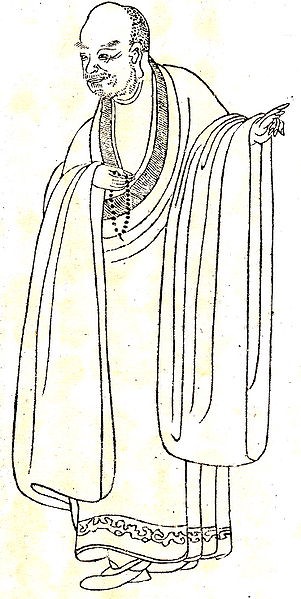 Image Source: Image depicting Luo Binwang. Wikipedia. Public Domain.
Image Source: Image depicting Luo Binwang. Wikipedia. Public Domain.
As the courts of imperial princes were abolished in 722 by Emperor Xuanzong in an attempt to limit their political influence, poets sought new patrons. They sought a wide audience outside the court and they developed the ?capital poetry?, which placed emphasis on the tonic system and on Buddhist and eremitic themes.
Hidden by bamboo, hear now and again a well-pulley turning,But at his window see only webs of spiders.Our host rests ever aloof, though not pleading sickness,In a circling wall of tangled growth, one aging scholar.
Poets would also celebrate the glory of the capital and the theme of individual loneliness among the urban crowd. The greatest poet of the high Tang era was Chen Ziang (661?702) who made the rejection of the contemporary world a major theme of his. This signaled a ?return to antiquity? and by the early eighth century some court poets developed an ?ancient style? poetry. Yuan Jie (719?772) would set out to write moralizing poetry in archaic diction. Du Fu (712?770) is regarded as China?s greatest poet. His greatness resulted from his comprehensive mastery of his poetic predecessors. A prominent theme of his poetry was long parting between friends.
From An Lushan to Collapse of the Dynasty
The An Lushan revolt continued from 756 to 763 and resulted in a breakdown of the institutional framework of the empire. Regional power became increasingly dominated by warlords. While An Lushan initially had some success, lack of progress led to his assassination in 757. This led to internal divisions among the rebels that allowed the imperial government to counterattack. The emperor allied himself with the Uighur Turks, which aided in suppressing the revolt but had long term negative consequences as they exploited the empire?s weakness.
After the suppression of the An Lushan rebellion, the provincial governors? forces became independent private armies, often fighting among themselves. New professional units were raised by the government to counter them, but they too proved difficult to control. In the 9th century the Shen-ts?e (?Divine Strategy Army?) was set up under the command of court eunuchs, and in 885 a new army that was 54,000 men strong was established. This force, however, was no match against the well trained veteran soldiers of the governors. By that time the Tang Dynasty was in severe decline.
 Image Source: Emperor Dezong. Wikipedia. Public Domain.
Image Source: Emperor Dezong. Wikipedia. Public Domain.
There were attempts to reverse this decline. Among them was a fiscal reform by Emperor Dezong (779?805) who in 780 introduced a new system of taxation that collected taxes twice a year according to the agricultural cycle and calculated taxes on the basis of property and cultivable land. It also allocated different tax quotas to different provinces. This new fiscal policy did strengthen central control but as stated above the imperial government was unable to bring to heel the regional governors. Attempts by Dezong to enforce centralized rule failed and a compromise was reached in 786 that recognized the de factor independence of several governors. The only good news for the Tang was the success of an invasion of Tibet in 801 that neutralized that threat in the West.
Emperor Xianzong (805?820) attempted in a series of military campaigns between 814 and 819 to defeat the governors and achieved some victories at great fiscal cost and was able to at least formally reunify China. His campaigns though had emptied the treasury and after his death in 820 this imperial resurgence came to an end. In 821 the three northeastern provinces rebelled and the court could do nothing. Xuanzong was followed by a succession of weak rulers dominated by court factions. From 840 to 859 there was a short-lived imperial revival but a chain of southern rebellions from 858 onward destroyed the dynasty. The revolts resulted in the sack of both Luoyang and Chang?an and large groups of bandits ravaged the countryside. Zhu Wen, originally a salt smuggler and rebel, surrendered to the Tang and offered his assistance in suppressing the revolt. He succeeded and gained rapid promotions. He increasingly dominated the court, killing the reigning emperor and replacing him with his young son Ai. In 907 he deposed Ai and declared himself Emperor, effectively ending the Tang Dynasty.
